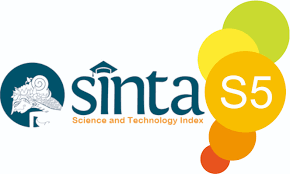Sistem Perancangan Monitoring Inravena (Infus) Berbasis Internet Of Things
Abstract
Giving drugs or fluids into the body through the mouth will enter the digestive process first so that it is not quickly absorbed by the body is a process of fluid entry or commonly called infusion. Infusion is done by inserting a small needle into the blood vessel flow with absorption speed depending on the patient's body condition and the disease suffered, therefore the infusion needs to be controlled when attached. The purpose of this study is to control the infusion system with the application of technology to support health facilities by building an automatic and portable intravenous fluid monitoring system using Telegram. This tool can also send notifications through buzzer alerts and Telegram Bot notifications so that it can be applied to information on services, treatment and registration systems at hospitals online. From the results of the study, several conclusions can be drawn, namely, the Intravenous Monitoring System is able to monitor the condition of the infusion using the Telegram application, by testing using 3 infusion bags with 500ml liquid each the device can measure infusion capacity data well, from the tests carried out obtained Telegram notification delay with an average of 5 seconds, but this can be influenced by internet network conditions, From the tests that have been done, the author concluded that the accuracy rate in this study was 98%.
Downloads
References
[2] G. Priyandoko, “Rancang Bangun Sistem Portable Monitoring Infus Berbasis Internet of Things,” JJEEE Jambura J. Electr. Electron. Eng., vol. 3, pp. 56–61, 2021.
[3] M. A. Aris Widya and P. Airlangga, “Pengembangan Telegram Bot Engine Menggunakan Metode Webhook Dalam Rangka Peningkatan Waktu Layanan E-Government,” Saintekbu, vol. 12, no. 2, pp. 13–22, 2020, doi: 10.32764/saintekbu.v12i2.884.
[4] Dahrony, “Pembuatan Sistem Otomasi Dispenser Menggunakan Mikrokontroler Arduino Mega 2560,” 2013.
[5] A. Imran and M. Rasul, “Pengembangan Tempat Sampah Pintar Menggunakan Esp32,” J. Media Elektr., vol. 17, no. 2, pp. 2721–9100, 2020, [Online]. Available: https://ojs.unm.ac.id/mediaelektrik/article/view/14193
[6] M. Ikhsan, “Rancang Bangun Alat Pengering Gabah Otomatis Menggunakan Sensor Berat Berbasis Arduino Uno,” Ranc. Bangun Alat Pengering Gabah Otomatis Menggunakan Sens. Berat Berbas. Arduino Uno, 2019.
[7] W. G. Siswanto, Gunawan Pria Utama, “JURNAL RESTI,” vol. 2, no. 3, pp. 697–707, 2018.
[8] K. Elektronika, “Pengertian Beterai dan jenis-jenisnya,” 2020. https://teknikelektronika.com/pengertian-baterai-jenis-jenis-baterai/
[9] Y. Iswanto, “Modul Charger,” pp. 4–16, 2021.
[10] M. Zarkasi, “Internet of Things,” pp. 4–20, 2019.
[11] F. V NURIZNA, “Penggunaan Bot Telegram Sebagai Announcement System Pada Layanan Psikotes Lembaga Konseling Cahaya Hati,” 2021, [Online]. Available: http://eprintslib.ummgl.ac.id/id/eprint/3501
[12] S. Syamsiah, “Perancangan Flowchart dan Pseudocode Pembelajaran Mengenal Angka dengan Animasi untuk Anak PAUD Rambutan,” STRING (Satuan Tulisan Ris. dan Inov. Teknol., vol. 4, no. 1, p. 86, 2019, doi: 10.30998/string.v4i1.3623.
Copyright (c) 2024 Raditya Frandika Irawan; Agung Kharismah Hidayah, Diana Diana, Dedy Abdullah

This work is licensed under a Creative Commons Attribution-ShareAlike 4.0 International License.
An author who publishes in Jurnal Media Infotama agrees to the following terms:The author holds the copyright and grants the journal the right of first publication of the work simultaneously licensed under the Creative Commons Attribution-Share Alike 4.0 License which allows others to share the work with acknowledgment of the work's authorship and initial publication in this journal.Submission of a manuscript implies that the submitted work has not been previously published (except as part of a thesis or report, or abstract); that it is not being considered for publication elsewhere; that its publication has been approved by all co-authors. If and when a manuscript is accepted for publication, the author retains the copyright and retains the publishing rights without limitation.
For new inventions, authors are advised to administer the patent before publication. The license type is CC-BY-SA 4.0.
MEDIA INFORMATION REVIEW: Journal of the Faculty of Computer Science is licensed under a Creative Commons Attribution-ShareAlike 4.0 International License.You are free to:Share
— copy and redistribute material in any medium or formatAdapt
— remix, modify and develop materialfor any purpose, even commercial.
The licensor cannot revoke this freedom as long as you follow the license terms












.png)


